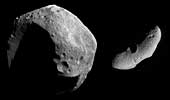|
COMETS EARTH JUPITER KUIPER BELT MARS MERCURY METEORITES NEPTUNE OORT CLOUD PLUTO SATURN SOLAR SYSTEM SPACE SUN URANUS VENUS ORDER PRINTS
PHOTO CATEGORIES SCIENCEVIEWS AMERICAN INDIAN AMPHIBIANS BIRDS BUGS FINE ART FOSSILS THE ISLANDS HISTORICAL PHOTOS MAMMALS OTHER PARKS PLANTS RELIGIOUS REPTILES SCIENCEVIEWS PRINTS
|
Related Documents
Download Options
Download Options
The NEAR Shoemaker spacecraft has scored two important firsts in the exploration of asteroids: it's the first to orbit an asteroid, Eros, and the first to encounter a denizen of the outer reaches of the asteroid belt, the C-type asteroid Mathilde. In a scheme that reflects how they have historically been a topic for astronomy, not geology, asteroids are classified into groups based on their colors as observed through telescopes. The two major classes of asteroids are called S-types and C-types. S-types, whose colors are consistent with "stony" or rocky compositions, prevail among asteroids that orbit closer to the Sun than the mid-point of the asteroid belt. Eros and the two asteroids encountered briefly by the Galileo spacecraft on its way to Jupiter -- Gaspra and Ida -- are all S-types. C-types like Mathilde have a dark gray color consistent with a "carbonaceous" composition, rich in carbon compounds and other dark materials. They prevail in the outer part of the asteroid belt. In this montage, Mathilde (at left) and Eros (at right) are shown at the same scale, as they were imaged by NEAR Shoemaker from about 1,800 kilometers (1,116 miles) on June 27, 1997, and February 12, 2000, respectively. Mathilde is 56 kilometers (35 miles) across, and Eros is 33 kilometers (21 miles) long and 13 kilometers (8 miles) wide. However, Mathilde's brightness is greatly exaggerated for viewing purposes -- it's actually six times darker than Eros, with about the same reflectivity as soot! |
